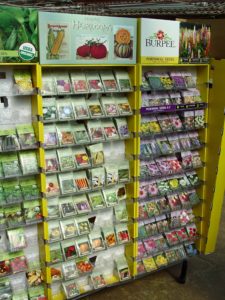Seed Slam, The Sequel
March 9th, 2021
I hope you got your 2021 supply of seeds already.
If not, you’d better get busy ASAP because we’re seeing another seed slam in which seed-sellers can’t get seeds in the packets and out the door fast enough to keep up with another huge-demand year.
For the second year in a row, seed companies find themselves caught in a vice between COVID-caused, order-filling handicaps and another spike in gardening demand. The result is order delays, sellouts of popular varieties, and in some cases, temporary ordering shutdowns.
It’s not so much a “seed shortage” as it is a series of bottlenecks in getting seed from the growers into gardeners’ hands.
“There’s plenty of seed around,” said Jeanine Bogard, manager of Syngenta Seed’s Home and Garden Vegetables program, during a National Garden Bureau panel discussion on the issue. “It just might not be in the specific variety people are looking for.”
“It’s mainly an issue of being able to fill packets fast enough to get them to customers in adequate time,” adds Nathan Zondag, vice president of operations for the Wisconsin-based Jung Seed Co.
Seed sales blew off the charts last year at this time when COVID lockdowns began and stuck-at-home Americans figured it would be a good time to grow their own food. The idea escalated when empty food shelves started appearing in grocery stores.
An estimated nine million new gardeners came out of the woodwork last year, says Curtis Jones, co-owner of the Colorado-based Botanical Interests seed company, and the vast majority of them intend to stick with it.
Massachusetts-based Griffin Greenhouse Supplies surveyed 1,000 of those first-time gardeners and found that 80 percent said they planned to continue gardening in 2021.
Despite seed companies ordering more seed to head off a repeat of last year’s COVID-fueled ordering slam, seed-buying is an adventure once again.
Between gardeners ordering early and even higher demand than last year, many seed companies have been back-ordering, selling out of selected varieties, taking longer than usual to fulfill orders, and in some cases, temporarily suspending orders or resorting to daily quotas and waiting lists.
Jones says retailers selling his company’s seed are reporting sales of one-third to one-half more than last year at this time.
So what to do?
Start by getting your order in now with your favorite company.
Don’t be surprised if you run into warnings about longer-than-usual turn-around times or even having to get on a waiting list to order, as Fedco Seeds has been doing.
If you get shut out, delayed, or find that a variety you want is already sold out, try another company. Not everyone is sold out of the same thing, and many sellouts are just temporary until companies can refill more packets from their bulk-seed bags.
Second, have a look at the seed racks at local stores and garden centers. These might not have the selection realm of catalogs, but they do give you seed in hand instantly.
Third, be willing to substitute. If your usual favorite is out of stock, try something else. You might find that you end up liking a substitute variety even better.
Fourth, don’t give up on seed left over from last year. Although a few crops (onions, lettuce, and corn, for example) are good only for a year or two, many vegetable and flower seeds are viable for three to five years – especially when stored well.
Read how to tell if your old seeds are still good and how to make them last
And fifth, snoop around for or initiate seed swaps. Friends, neighbors, and fellow gardeners might have seeds left over from too-big packets that they’re willing to share or swap for your excesses.
Online offers often pop up on social-media platforms, while some garden clubs, local groups, and even an occasional library organize swaps.
The Iowa-based Seed Savers Exchange is a national (and free) seed-swapping service that also offers tips on how to start a local seed swap.
While you’re at it, you might want to get your order in ASAP for any live plants you plan to acquire online or by mail-order this year.
Those orders already are running high as well with vendors expecting more and sooner sellouts than usual and longer/later ship times.
“April is the month when we send out most of our (live) stuff,” says Jung’s Zondag. “So now you have this issue where we’re collecting orders from Christmas through the end of March and then trying to get everything out the door in April. Typically, it’s really crazy in April. This year it’s going to be even crazier.”
See George’s list of 10 favorite seed and garden-supply catalogs









